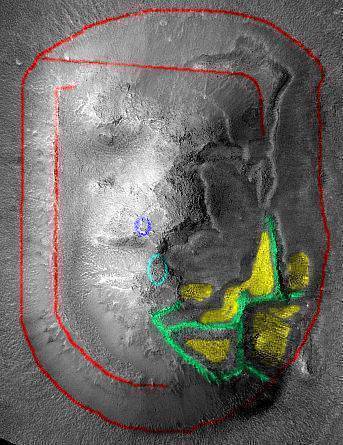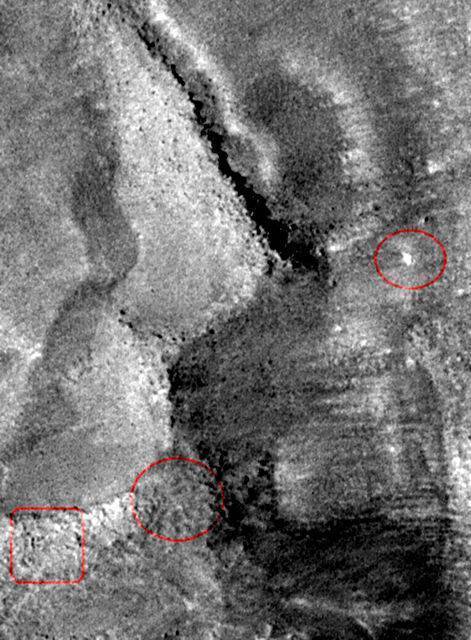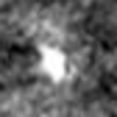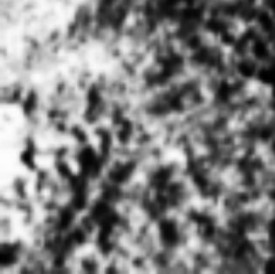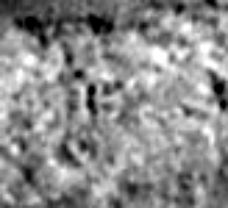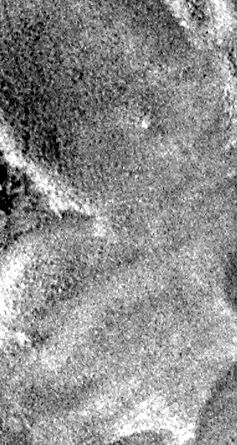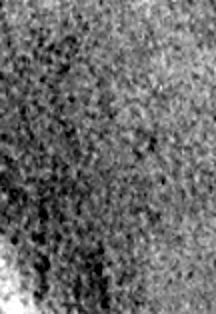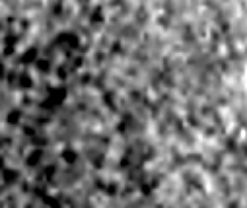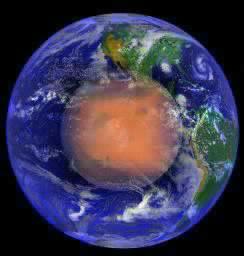 Cydonia Quest Behind the Mask C Part Five The Elephant in the Room
In this section we return to the evidence for large scale geometrical design and the existence of major support structures within the "Face". It will also deal with what I call "the elephant in the room". The "annotated" illustration on the left outlines the outer boundary of the "Face" and certain geometric regularities in red. Apart from stretches of the eastern side (where the slope of the "Face" platform seems to have slumped outwards a bit) the overall boundary shape appears remarkably geometric and artificial. The parallel relationship between the bottom and top of the "Face" platform on the western side also seems rather precise for a natural feature. The red line cutting across the forehead of the "Face" is a remarkably straight collection of grooves and edges that were even apparent in the 1976 Viking pictures. This feature marks a particularly important line in the controversial Torun & Hoagland General Geometrical Model of Cydonia (click "stargate" µµµ). I've extended the line around the curve of the "Lion's" head as it seems to change direction and head South at this point.
|
This brings us to "the elephant in the room". Perceptive readers will have noticed that when the analysis of the 1998 "Face" image was made in Part Two (µµµ), mention of the south east quadrant of the "Face" was scrupulously avoided. This was because I could not make sense of how the jumble of ridge lines to be seen there fitted into a sculptured face. It looked as if they might be very much natural features - which of course would tend to undermine the artificiality hypothesis for the "Face". Judgement was therefore reserved for that time when a full overhead image of the "Face" was obtained. Now that such an image has been taken it is clear that these ridge lines are not an embarrassment for the artificiality hypothesis, but instead tend to undermine the natural origin hypothesis for the "Face". (This could now make them the "elephant in the room" that NASA is reluctant to talk about). The April 2001 image of the "Face" reveals these ridges to be a partially exposed grid of massive walls. The "annotated" illustration above high-lights these walls in green. It can be seen that their layout is strikingly geometric - and artificial looking. In its Arcology studies Cydonia Quest has argued that the ridge lines to be seen in many anomalous Cydonia mounds are the eroded tops of massive walls giving structural support to areas honeycombed with chambers that lie between them. A recent study of the "SuperBowl" provided strong visual evidence that interior artificial chambers were indeed sandwiched between radiating support walls (click this "stargate" µµµ). Now the April 2001 image of the "Face" confirms that these theorised walls do in fact exist. The main illustration below is a full sized section taken from the new image showing how credible these walls are as artificial structures. If we go back to the "annotated" image above it will be found that if the end of the northern most of these walls is extended northwards, then it is in alignment with the red line that has been extended southwards down the straight edge of the "Lions" head. This is a good indication that the grid of walls in the south east quadrant is tied in with a more extensive geometrical pattern underlying the "design" of the "Face". C
c The pictures down the side of the main illustration above are enlargements of some of the interesting features to be found around the grid of walls and which are circled in red. The top picture is of a junction in the walls where there appears to be some rectilinear constructional details, especially a large rectangular enclosure. This part of the wall system seems to be covered with something like dark soot, but it isn't something contrast enhancement can't crack. The middle picture shows a very reflective tetrahedral object that lies on the outer fringe of the "Face" apron. A pixel count indicates that it is about 130 feet across. The interesting part of the bottom picture in the series is on the centre left. There are some low, parallel walls here that are aligned towards the top and bottom of the picture. A right angled intersection can also be made out. In the lower left quadrant of the picture two of these walls flow away from a perfectly circular wall surrounding a depression with a large block in the centre. The circular feature is highly anomalous, especially as it is obviously related to the other nearby walls. All these constructional looking details (in the two segments of the major wall system that have been enlarged) suggest strongly that the grid of major walls in the south eastern quadrant of the "Face" are artificial structures. C A quick look at a natural explanation. In one of its very first articles Cydonia Quest suggested that the most likely natural explanation for the anomalous shapes of the Cydonia anomalies was that they were underpinned by volcanic dykes. These are natural walls formed by magma rising up through fault lines in soft rock, cooling and then being exposed as the softer rock erodes away. It was suggested that if a system of faults were laid out in a geometrical way then a geometric system of volcanic dykes would also be created and so any hill that they formed would also erode back to a geometric shape. However, the enlargements above reveal more than just rectangular blocks of basaltic rock making up the "Face's" massive walls. As we have seen there is what seems to be fine architectural detail on their surfaces. Anyway, from the East Formation (µµµ) to the D&M Pyramid (µµµ), the sheer number of Cydonia mounds with what looks like designed layout is making the argument for volcanic dykes naturally laid out in geometric patterns look untenable. C Why are the walls exposed? One reason why the grid of walls in the south east "Face" quadrant might be exposed is that the material between them subsided into hollow space. There are indeed a number of hollows surrounding the walls, which are shaded in yellow in the "annotated" illustration at the top of the page. After examining the full sized image of the area in some detail I find that there is some evidence that material has slipped away from the side of the walls that face the exterior of the "Face". However, few of the hollows that are on the interior side of the walls show evidence of being formed by subsidence. This leaves the possibilities that (A) this quadrant of the hypothetical artificial "Face" wasn't actually completed or (B) that the builders intended the main walls to remain exposed here to create a rectilinear frame for the facial features enclosed within. C The Bare Faced Cheek This title refers not to NASA's "Catbox" image of the "Face", or even their attempt to sink the artificiality hypothesis with blatantly warped analysis in their recent news coverage of the "Face". It actually refers to the "cheek" area between the "eye", "nose" and the grid of walls in the south east. From the "annotated" illustration the reader might be forgiven for thinking that this area is made up of small rocks that have rolled down from erosion around the edge of the "nose". This is also the impression one would get from the dark and poorly contrasted full sized image as published on the MSSS website. If this was an area of debris flow then it would tend to undermine Richard Hoagland's theory that the eastern side of the "Face" has the facial features of some creature that looks like a lion. A massive debris flow would mean that the shape of this part of the "Lion's" face would be accidental rather than due to any actual underlying "design". However, once this area is contrast enhanced it is quickly apparent that it has a rough surface with vague criss-crossing features on it. The image on the left below shows most of the area at full size with contrast enhancement. The top right image shows part of this area enlarged by a factor of two with further contrast enhancement. On the bottom right is an even smaller area enlarged by a factor of four. The important thing to notice in these images is that (A) the surface is made up of car sized blocks, (B) few of these blocks appear to be loose from the surface, and that (C) there is an underlying uniformity and criss-cross alignment to this block-like surface. In short this is not a debris flow. It is a solid, bare surface (and Richard Hoagland can rest easy). C ccccccccccccccc
In an article compiled by Kynthia (TEM's artist) Ron Nicks (TEM's geologist) points out that the western "Ape-man" side of the "Face" has suffered more from dust blasting due to the prevailing wind direction at Cydonia (click next "stargate" µµµ). As a result of this millennia of steady erosion the western side of the "Face" has lost most of its original surface. It is certainly the case that there are very few areas on the western side of the "Face" were the surface is as relatively smooth as in the images just reviewed. It would seem that the blocks seen in the images above are the original (but wind eroded) casing stones that once covered the whole of the hypothetical artificial sculpture of the "Face" when it was brand new. One of the most interesting things in the Kynthia article is the picture showing how a pyramid, with its layers of individual stone blocks, has a similar erosional pattern to the eastern side of the "Face". C Conclusions Preparations for the Cydonia Quest section on the "Face" first began before Christmas 2000. As it has progressed NASA and Dr. Michael Malin have "helpfully" released new images of the "Face" and so the period of writing and analysis has become rather extended. It is now the 2nd June 2001 and I think it is time to bring this five part section to a close.
After careful analysis of the "Face" images released in January and May 2001 in Parts Three (µµµ), Four (µµµ) and Five, my conclusion is that the "Face" is very credible as the ruin of a constructed facial sculpture. Nobody can know for sure whether the "Face" actually is or is not a weird artificial structure. There is currently insufficient data. However, in my opinion, those who over the years have advocated the artificiality hypothesis have a stronger case now than when they started out with the 1976 Viking images. Now that's an interesting thought, especially with all the other artificial looking stuff crowding the Cydonia plain. Good places to look for updates on the "Face" are the Enterprise Mission (µµµ) from 25th May 2001 onwards, and the Cydonian Imperative (µµµ). . µ Previous Page µ Back to the Mars Page µ Back to Cydonia Quest Main Page
|
